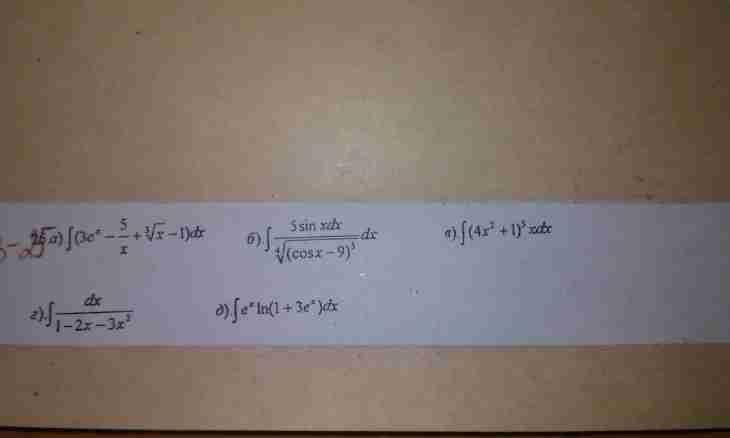Integration and differentiation — bases of the mathematical analysis. In turn, play a major role of a concept of a certain and uncertain integral in integration. Knowledge what is uncertain integral, and the ability is correct it are necessary to find to everyone, studying the higher mathematics.
Instruction
1. The concept of uncertain integral is brought out of a concept of primitive function. The F (x) function is called an antiderivative for the f (x) function if on all field of its definition of F ′ (x) = f (x).
2. Any function with one argument can have no more than one derivative. However with antiderivatives it not so. If the F (x) function is an antiderivative for f(x), then the function F (x) + C where C — any nonzero constant, will be for it an antiderivative too.
3. Really, by the rule of differentiation (F(x) + C) ′ = F ′ (x) + C ′ = f(x) + 0 = f (x). Thus, any antiderivative for f(x) looks as F(x) + C. This expression is called uncertain integral of the f (x) function and ∫f(x)dx is designated.
4. If function is expressed through elementary functions, then its derivative too is always expressed through elementary functions. However for antiderivatives it is also incorrect. A number of simple functions, such as sin(x^2), the uncertain integrals which are not expressed through elementary functions have. It is possible to integrate them only approximately, numerical methods, however such functions play an important role in some areas of the mathematical analysis.
5. The simplest formulas for uncertain integrals are brought out of rules of differentiation. For example, ∫ (x^2) of dx = (x^3)/3, as (x^3) ′ = 3x^2. In general, for any n ≠-1 it is right that ∫ (x^n) of dx = (x^(n+1))/(n+1). At n =-1 this expression loses the meaning, however the f (x) function = 1/x, nevertheless, it is integrated. ∫ (1/x) dx = ∫dx/x = ln |x| + C. Pay attention that the ln |x| function, unlike the ln (x) function, is defined on all valid axis, except for zero, just as function 1/x.
6. If the f (x) and g (x) functions are integrated, then their sum is also integrated, and ∫ (f(x) + g (x) dx = ∫f(x)dx + ∫g(x)dx. If the f (x) function is integrated, then ∫af(x)dx = a∫f(x)dx. These rules can be combined. For example, ∫ (x^2 + 2x + 1) dx = (x^3)/3 + x^2 + x + C.
7. If ∫f(x)dx = F(x), then ∫f(x+a)dx = F(x+a) + C. It is called leading under the sign of differential constant composed. Under the sign of differential it is possible to bring also a constant multiplier: ∫f(ax)dx = F(ax)/a + C. Combining these two receptions, we will receive: ∫f (ax + b) dx = F (ax + b) / a + C. For example, if f(x) = sin (2x + 3), then ∫f(x)dx = - cos (2x + 3)/2 + C.
8. If the integrated function can be presented in the form of f (g(x)) *g ′ (x), for example, sin^2(x) *2x, then this function is integrated by method of replacement of a variable: ∫f (g(x)) *g ′ (x) dx = ∫f (g(x)) dg(x) = F (g(x)) + C. This formula is brought out of a formula of derivative difficult function: f (g(x)) ′ = f ′ (g(x)) of *g ′ (x).
9. If the integrated function it is possible to present in the form u (x) *v ′ (x), then ∫u(x)*v ′ (x) dx = uv - ∫v(x)*u ′ (x) dx. It is an integration method in parts. It is used when derivative of u(x) it is much simpler, than from v (x). For example, let f(x) = x*sin(x). Here u(x) = x, v ′ (x) = sin(x), therefore, v(x) = - cos(x), and u ′ (x) = 1. Then ∫f(x)dx = - x*cos(x) - ∫ (-cos(x)) dx = sin(x) - x*cos(x) + C.

